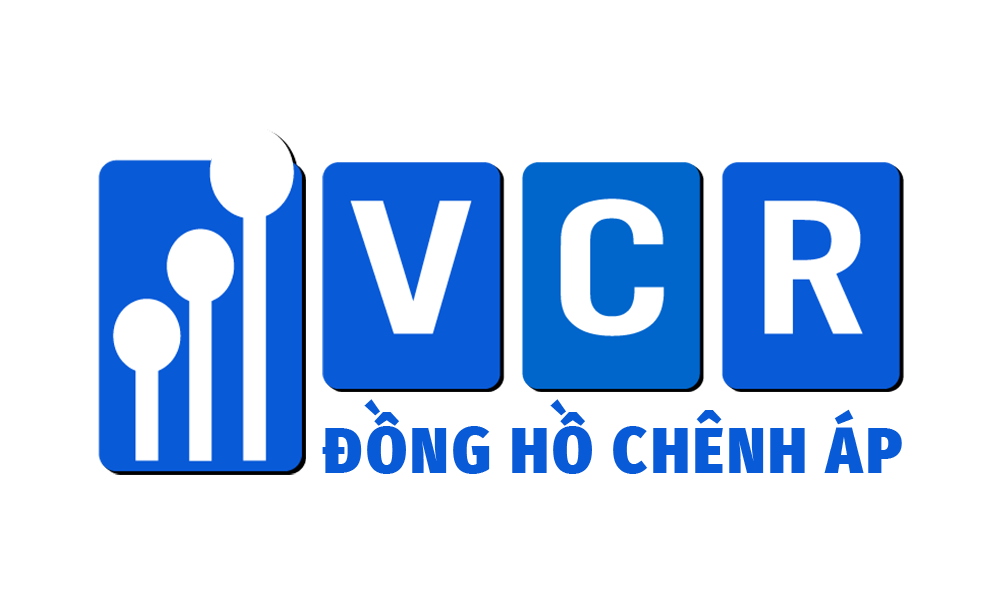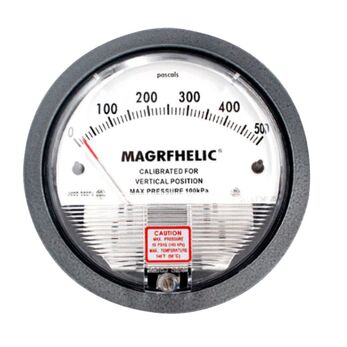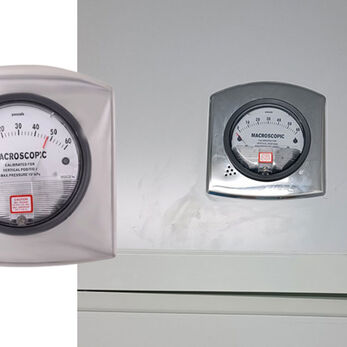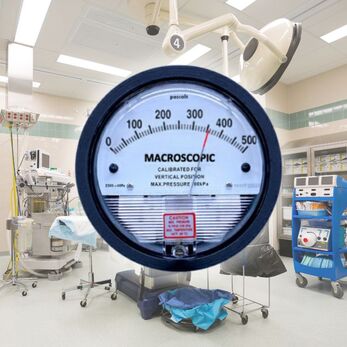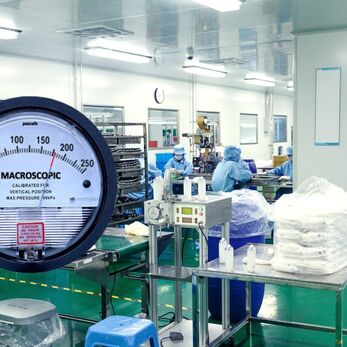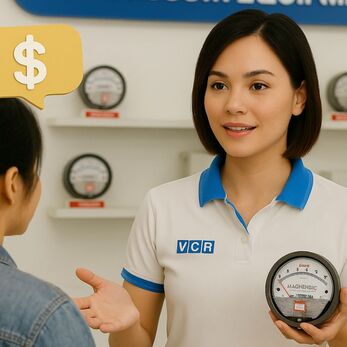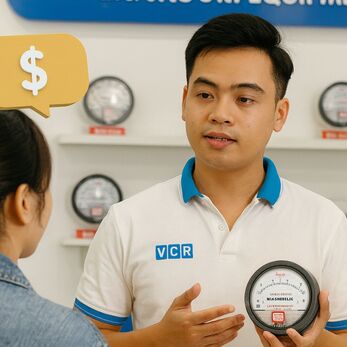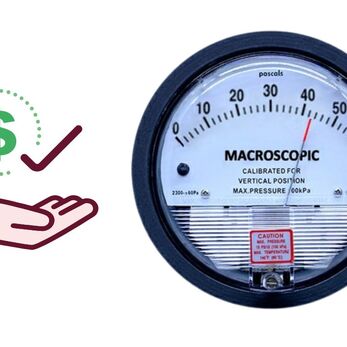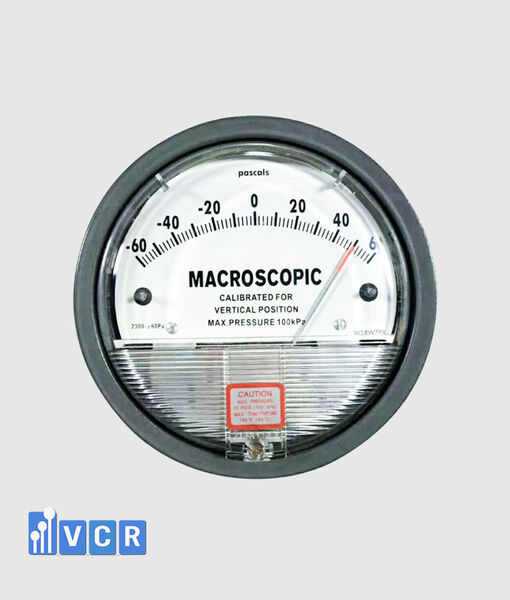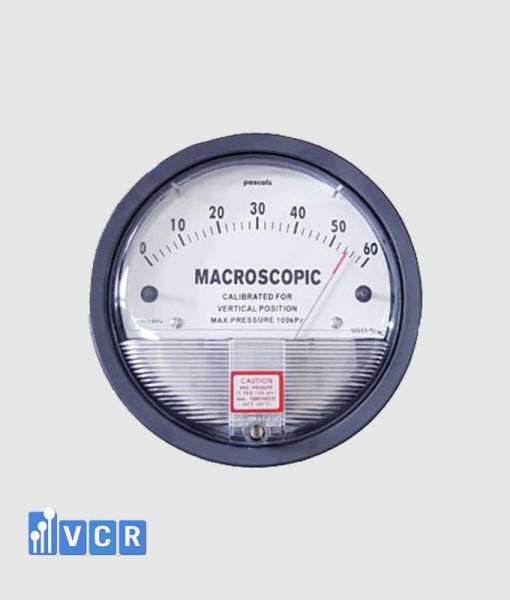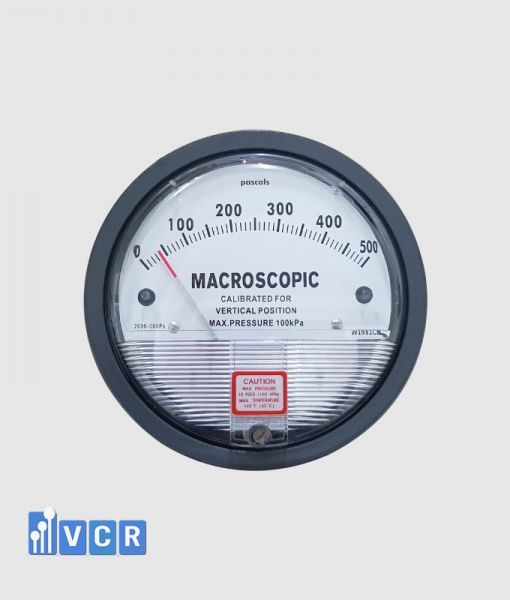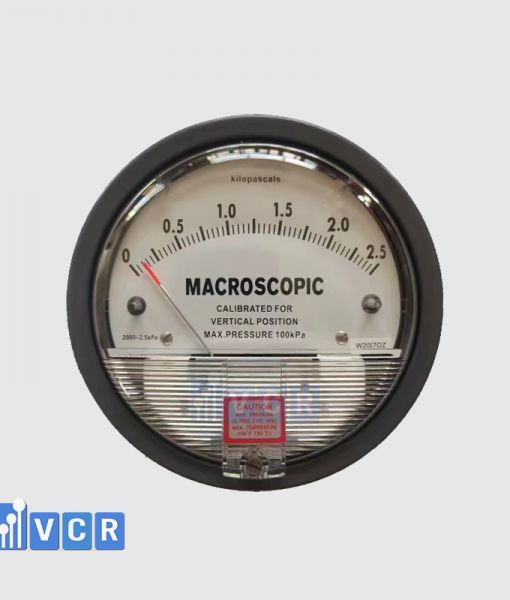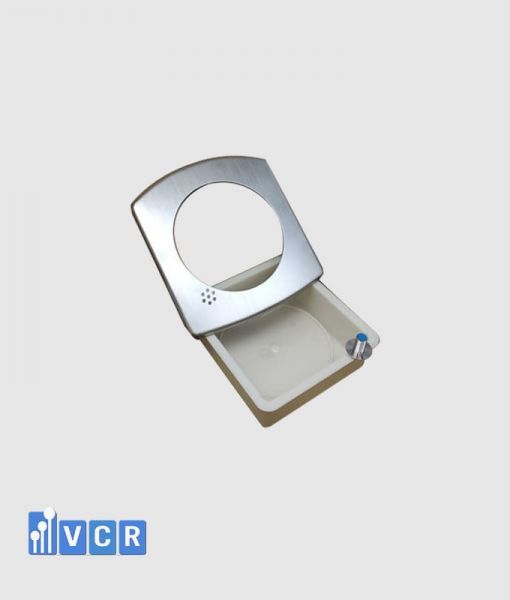2025 marks a major transformation in cleanroom pressure measurement technology-the rise of the digital differential pressure gauge. With high accuracy, Modbus/BACnet connectivity, and intelligent over-limit alarm features, it has become the inevitable trend replacing traditional analog gauges across all industries that require environmental control
- 1. Overview of Digital Differential Pressure Gauges
- 2. Why Digital Differential Pressure Gauges Are the Trend in 2025
- 3. Notable Applications of Digital Differential Pressure Gauges
- 4. Criteria for Selecting the Right Digital Differential Pressure Gauge
- 5. Product Suggestions: Top 3 Digital Differential Pressure Gauges Worth Noting in 2025
- FAQ
This article by VCR will help you clearly understand why we say “Digital Differential Pressure Gauges: The New Trend of 2025” including the concept, reasons why this device is increasingly popular in standard-compliant factories, along with the selection criteria and how to integrate it into clean-room environment monitoring systems.
1. Overview of Digital Differential Pressure Gauges
A digital differential pressure gauge is a specialized device to measure the pressure difference between two areas—typically between two clean rooms or between a clean environment and the surrounding environment. This device uses a digital pressure sensor, processes the signal via an electronic micro-circuit, and displays the result visually on an LED or LCD screen.
Unlike a traditional mechanical dial gauge, the digital device not only provides more precise pressure readings but also supports advanced features such as threshold alerts, networked monitoring and real-time data logging.
Comparison: Digital vs. Traditional Mechanical Dial
| Criterion | Traditional Dial Gauge | Digital Differential Pressure Gauge |
|---|---|---|
| Accuracy | ±2.5% to ±1% F.S. | ±1% to ±0.25% F.S. |
| Display method | Manual reading by eye | Digital screen, clear display |
| Threshold alert | None | User-configurable alerts |
| Data logging | Not supported | Logging or data transmission supported |
| System connection | Not supported | Supports Modbus, BACnet, 4-20 mA |
| Maintenance & calibration | Manual monitoring | Alert for deviation, easier calibration |
Typical industries that require strict environmental control include:
-
Pharmaceuticals: monitoring differential pressures between manufacturing rooms, weighing rooms, packaging rooms to maintain proper airflow direction in accordance with GMP-EU and FDA standards.
-
Food: ensuring positive pressure in clean processing zones to avoid cross contamination from external environments.
-
Electronics: controlling static pressure to protect sensitive components from dust and electrostatic discharge.
-
Cosmetics: ensuring sterile conditions in mixing and packaging rooms.
Commonly applied standards include:
-
ISO 14644-1: Standards for cleanroom air cleanliness classification.
-
GMP (Good Manufacturing Practice): required for pharmaceutical, cosmetic, and functional food production.
-
FDA (21 CFR Part 11): requirements for electronic records and traceability in the pharmaceutical industry.
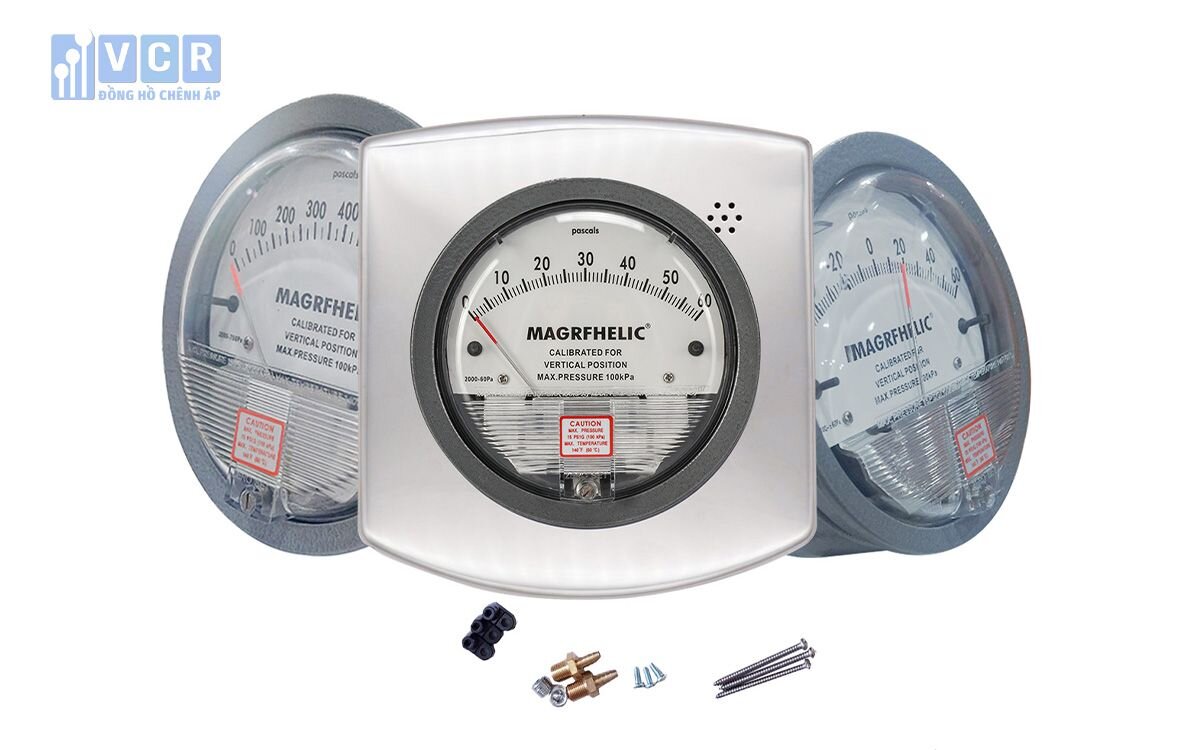
Read more: Latest price list of Differential pressure gauge used in electronics factory
2. Why Digital Differential Pressure Gauges Are the Trend in 2025
Strong growth of standard-compliant factories
In recent years, investment in GMP-certified factories, ISO 14644, ISO 9001 has increased rapidly, especially in sectors such as pharmaceuticals, functional foods and electronics. This has led to stricter requirements for environmental control—particularly for differential pressure between clean rooms. Digital differential pressure gauges naturally become the inevitable choice to ensure regulatory compliance, maintain stable production environments, and optimize operational efficiency.
Stricter differential pressure control requirements
In clean environments, even a small pressure deviation may lead to cross contamination, leakage of airflow or imbalance in air circulation. Regulatory bodies (e.g., FDA, WHO) require that differential pressures between rooms be maintained within ±15 Pa and need continuous monitoring. Digital gauges with high-sensitivity sensors and real-time display help maintain this control.
Digitization of manufacturing
As the wave of digital transformation in manufacturing accelerates, companies not only want manual measurement but also to connect devices to an overall system. Digital differential pressure gauges, with smart communication capabilities (Modbus, BACnet…), support uploading data to the cloud or integration into digital platforms—thereby enhancing monitoring, analysis and optimization in real time.
Integration with BMS/SCADA and remote IoT monitoring
Thanks to system connectivity, these devices can easily integrate into:
-
Building Management Systems (BMS)
-
SCADA control centers
-
IoT remote monitoring applications
Personnel can check differential pressure in each area remotely via a dashboard interface or receive alerts on their phone when pressure exceeds thresholds.
Operational and maintenance optimization
Digital gauges help reduce cost and effort for operations:
-
Alerts on large deviations: When differential pressure exceeds the set threshold, the system can trigger lights/alarms or send notifications via email/SMS for quick response.
-
Automatic data logging: All readings are stored as logs, avoiding manual recording errors and enabling easier audit tracing.
-
Audit readiness: During inspections or internal evaluations, the ability to trace historical differential pressure data is always emphasized. Digital gauges with built-in memory and accompanying software enable:
-
Long-term data storage
-
Quick generation of PDF/Excel reports
-
Proof of compliance with environmental standards
Together, these help factories to smoothly pass GMP, ISO or FDA audits.
-
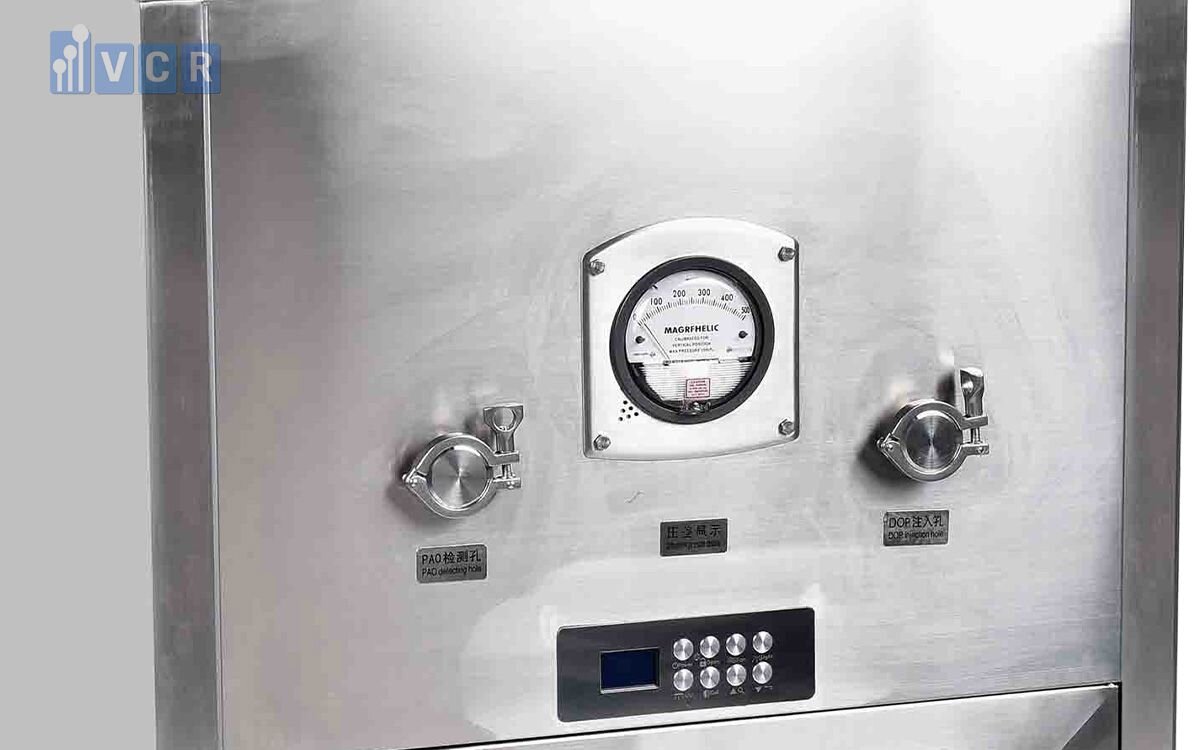
Read more: Differential Pressure Gauge Costs: A Guide for Vietnamese Cleanrooms
3. Notable Applications of Digital Differential Pressure Gauges
In modern manufacturing, maintaining stable differential pressure between areas is a key factor to ensure cleanliness, safety and product quality. Digital differential pressure gauges with precise measurement and remote-monitoring integration have become indispensable tools in many critical industries:
Pharmaceutical industry
-
Typical application: Monitoring clean production rooms for injectables, ingredient weighing rooms.
-
Requirement: Areas like preparation rooms and filling/packing rooms require a stable positive pressure to prevent microbial intrusion; weighing rooms often need negative pressure to avoid dust spreading. Digital gauges help monitor in real time and send alerts when pressure exceeds limits, supporting GMP compliance and FDA inspections.
Food industry
-
Typical application: Monitoring pressure in sterile processing zones (“clean zone”).
-
Requirement: During processing of dairy, beverages or functional foods, the sterile zone must maintain positive pressure to prevent microbial contamination from outside. Digital gauges allow connection to SCADA/BMS systems, making it easy for QA to retrieve data during audits.
Electronics industry
-
Typical application: Controlling differential pressure at SMT zones, electrostatic control areas.
-
Requirement: The process of manufacturing microchips and circuit boards demands tightly controlled dust environments. Differential pressure gauges help maintain stable pressure between zones, thereby reducing airflow carrying dust into key areas. Some models integrate alerts via email or central system when abnormal variations occur.
Cosmetics industry
-
Typical application: Ensuring stable pressure conditions in mixing and filling processes.
-
Requirement: Production process of cosmetics (creams, serums, lotions…) demands clean and stable air to avoid cross contamination between product batches. Digital differential pressure gauges help maintain the standard environment and provide traceability data for quality audits.
Read more: Digital Differential Pressure Gauge Installation: A Comprehensive Guide
4. Criteria for Selecting the Right Digital Differential Pressure Gauge
Choosing the correct type of digital differential pressure gauge not only helps accurately measure pressure differences between two zones but also contribute to the stable operation of the entire clean-room system or production area. Here are 5 key technical criteria you should pay attention to:
Measurement range & accuracy:
- Each environment will have different differential pressure range requirements; commonly: ±50 Pa, ±100 Pa – for pharmaceutical, electronics cleanrooms; ±500 Pa or more – for HVAC zones and air handling processes.
- Higher accuracy is better, especially for strict control environments such as pharmaceuticals (GMP): ±1% or ±0.5% full scale. In weighing rooms – injection rooms: low error helps better control airflow.
Note: Choose a measurement range just sufficient for the application; avoid selecting an excessively large range which reduces resolution.
Signal output standards:
- Ability to connect to central monitoring systems is essential in the digital transformation era:
-
-
-
Analog 4-20 mA: common, easy to integrate with most PLCs and data loggers
-
Modbus RTU (via RS485): stable digital communication used in BMS/SCADA systems
-
BACnet MSTP/IP: standard for HVAC and smart buildings
-
Wireless (LoRa, WiFi): suitable for environments where wiring is difficult or remote monitoring is needed
Note: Verify compatibility with the existing plant infrastructure to avoid extra conversion cost.
-
-
Display & alert functions:
- Digital gauges not only measure but should support real-time monitoring:
-
-
-
LED/LCD display: clearly shows differential pressure value in real time
-
Warning lamp and alarm buzzer: signals when the preset threshold is exceeded (e.g., >15 Pa)
-
Flexible threshold configuration: allow setting min/max alert values
Note: Choose a device with wide viewing angle and back-lit display to ensure easy reading in production environments.
-
-
Calibration & data traceability capability:
- On-site calibration (zero/span): convenient for periodic maintenance, saving cost of sending out device
- Communication ports to export data: useful for storing or auditing GMP/ISO compliance
- Internal memory: some models can store measurement data over many days
Note: For factories meeting GMP or ISO standards, calibration certificates must be provided when installing or maintaining the device.
Material durability & environmental protection rating:
- Differential pressure gauges are often installed in areas with high dust, humidity or corrosive environments:
-
-
Housing material: ABS, polycarbonate, stainless steel depending on the usage environment
-
Protection rating:
-
IP65: fully dust-protected and resistant to low-pressure water jets
-
IP67: dust-proof and capable of short-term immersion—suitable for areas cleaned frequently
-
-
-
Note: In food or pharmaceutical environments, prefer sealed design, easy to clean and without gaps.
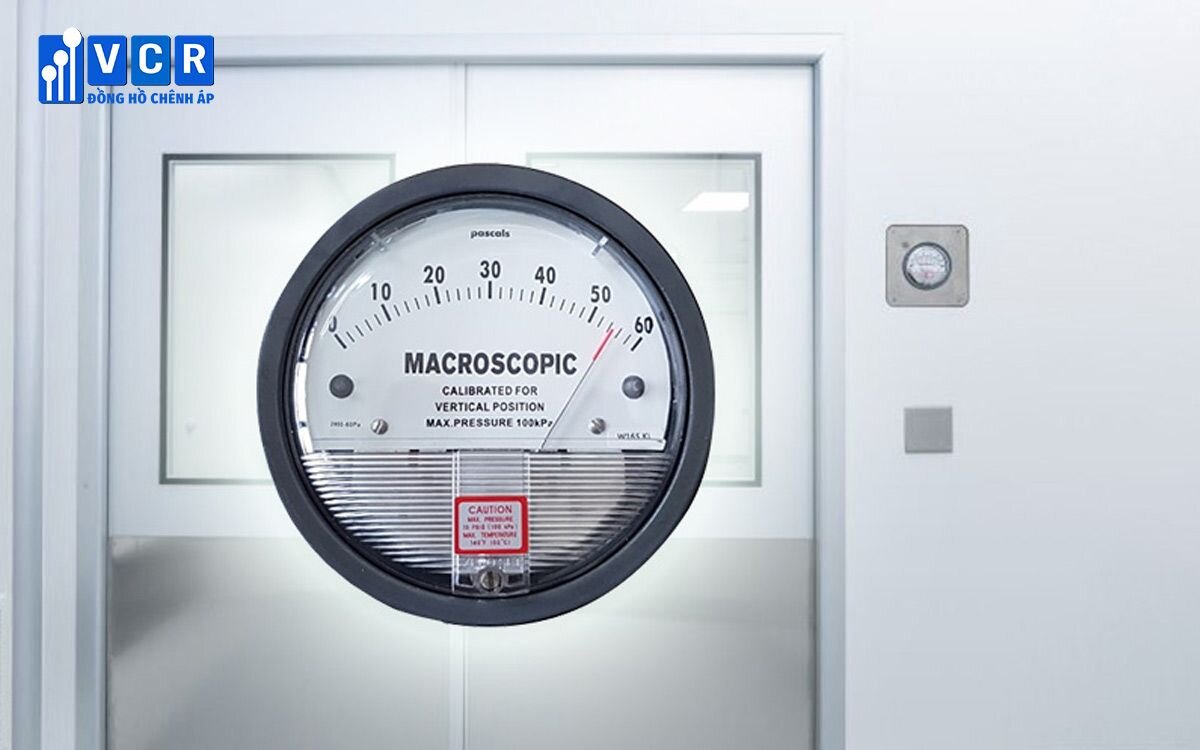
Read more: Selecting the Perfect Differential Pressure Gauge for Your Cleanroom
5. Product Suggestions: Top 3 Digital Differential Pressure Gauges Worth Noting in 2025
The year 2025 marks a strong transition from mechanical differential pressure gauges to digitally integrated models. Below are three models highly rated by clean-room experts and HVAC engineers, suitable for GMP/ISO standard environments:
Comark C9500 (UK)
- Accuracy: ±0.5% F.S.
- Large friendly LCD interface
- Two-direction differential pressure measurement (Positive/Negative) version available
- Suitable for: Clean-room calibration, field measurement
- Integration: USB port, analysis software included
Dwyer Magnesense® II Series (MS2) (USA)
- Measurement range: from ±25 Pa to ±5000 Pa
- Dual output signals: 4-20 mA and Modbus RTU
- Noise filter function – stabilizes signal when pressure fluctuates
- Suitable for: BMS/HVAC integration, pharmaceutical & electronics cleanrooms
- Additional: DIN rail mounting, electronic calibration available
Kanomax 3520 Series (Japan)
- High sensitivity, fast response in micro-pressure environments
- Compact wall-embedded design
- LED display shows actual pressure values
- Suitable for: Micro-electronics plants, microbiology clean-rooms
- Additional: Alerts when pressure threshold exceeded
Quick comparison of the three models
| Model | Origin | Accuracy | Output signal | Main Application |
|---|---|---|---|---|
| Comark C9500 | UK | ±0.5% F.S. | USB | Calibration, field measurement |
| Dwyer MS2 | USA | ±1% F.S. | 4-20 mA, Modbus | HVAC, BMS, GMP environments |
| Kanomax 3520 | Japan | ±0.25% F.S. | Analog / Relay | Electronics clean rooms |
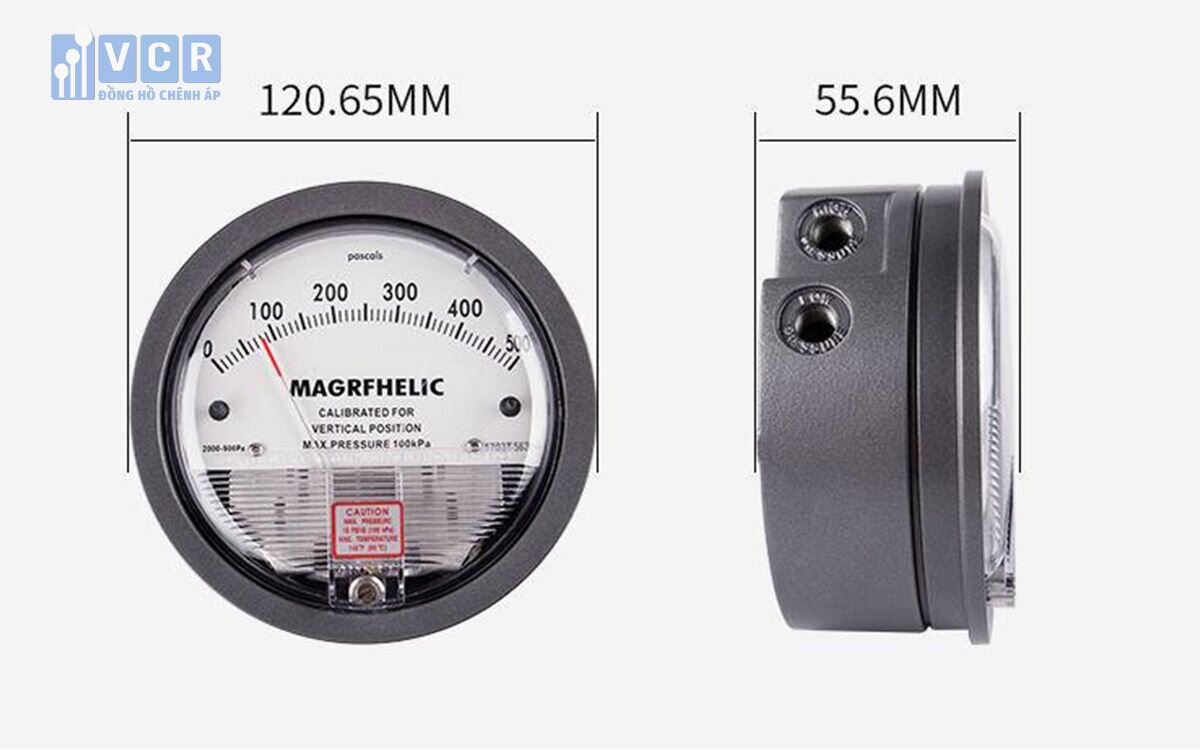
Read more: Supplier of Differential Pressure Gauges for GMP Clean Rooms
FAQ
1. Can a digital differential pressure gauge replace a mechanical dial gauge?
Yes. Most current digital differential pressure gauges are designed in sizes and connection standards similar to mechanical dial gauges (e.g., 1/8″ NPT thread, 100 mm or 160 mm face size). The replacement is very simple:
-
Keep the existing piping and installation position
-
Supply power (typically 24 V DC)
-
Reset zero point and measurement range
-
Check output signal (if connecting to BMS)
This is an upgrade solution without changing existing infrastructure.
2. Is periodic calibration necessary?
Yes, calibration every 6 months is recommended. Digital differential pressure gauges still accumulate error over time due to environmental influences (vibration, humidity, etc.). To ensure device remains accurate—especially in high-requirement environments such as:
-
Injectable drug production rooms (GMP-EU Class B)
-
High-tech electronics assembly cleanrooms (ISO 14644-1 Class 5)
then periodic calibration is mandatory. Recommended cycles: -
6-monthly for pharmaceutical and electronics factories
-
12-monthly for non-strict civil applications
Calibration may be done on-site or sent to the manufacturer depending on usage conditions.
3. Can digital gauges operate reliably in high-humidity environments?
Yes, if the correct type is selected. In high-humidity zones such as cleanrooms’ ante-rooms, food processing areas, or near frequent washing zones, the device must have:
-
Minimum protection rating of IP65 (fully dust-proof and resistant to low-pressure water jets)
-
Housing made of anti-oxidation material (such as stainless steel, powder-coated aluminium)
-
Inside circuitry with moisture-resistant coating or filtered ventilation membrane
When purchasing, ask clearly the supplier about the usage environment so you choose the correct model.
4. Can the gauge be connected to central monitoring software?
Yes, and this is a major advantage of the digital type. Most new digital differential pressure gauges support communication via:
-
Modbus RTU via RS485 – the most common protocol
-
Modbus TCP/IP – used in industrial LAN networks
-
BACnet MSTP or BACnet/IP – used in building control systems (BMS)
When connected, users can: -
Monitor pressure data in real time
-
Set up alert thresholds
-
Log data for audit and GMP/ISO compliance
Depending on the existing monitoring system (SCADA, BMS, HMI…), the factory can integrate quickly without major hardware changes.
Need advice on choosing a digital differential pressure gauge?
Don’t let outdated devices compromise your cleanroom performance and factory efficiency.
Contact VCR today for a free consultation with our experts on:
Selecting the right model for your industry (pharmaceutical, food, electronics, etc.)
Proper installation and calibration following GMP and ISO standards
Integration with your existing monitoring systems (BMS, SCADA, etc.)
Contact:
Hotline: 090.123.9008
Email: [email protected]
Website: https://donghochenhap.com/
Dat VCR


